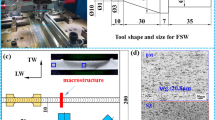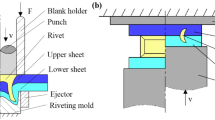Abstract
Upsetting with a controllable deformation zone (U-CDZ) is a newly developed sheet-bulk forming method to thicken the sidewall of a cup. It can avoid buckling on the inner surface of the tube with the help of a suitable counter force. The current studies about this process are all based on the case of double thickness ratio. This study focused on the forming procedure under larger thickening ratio and analyzed the material flow during the process. An improvement of the tool structure which is beneficial to the forming quality is proposed and verified. The radial extrusion process is used for the investigation of the thickening limitation of U-CDZ process based on the improvement. The critical flange length of radial extrusion process is considered as the reflection of the thickening limitation. The Latham-Cockcroft ductile fracture criterion is calibrated for the numerical simulation prediction of the critical flange length. The thickening limitation of U-CDZ process is obtained based on the experimental and simulation results. Minimum counterforce under different thickening ratio is acquired through numerical simulation, which is used for the establishment of process window in combination with critical thickening ratio.

















Similar content being viewed by others
References
Merklein M, Koch J, Schneider T, Opel S, Vierzigmann U (2010) Manufacturing of complex functional components with variants by using a new metal forming process–sheet-bulk metal forming. Int J Mater Form 3(1):347–350
Mori K, Nakano T (2016) State-of-the-art of plate forging in Japan. Prod Eng-Res Dev 10(1):81–91
Li YT, Dong WZ, Lin QQ, Wang ZG (2022) Deformation characteristics and fracture failure of multi-bosses forming process by plate forging. Int J Adv Manuf Tech 120(1):1001–1012
Wang ZG, Hakoyama T, Endo Y, Osakada K (2019) Application of flow model in metal cutting to cold forging of tubular products. CIRP Ann-Manuf Techn 68(1):273–276
Wang XY, Guo ML, Luo JC, Ouyang K, Xia JC (2011) Stamping-forging hybrid forming of double layer cup with different wall thicknesses. Mater Res Innov 15(s1):435–438
Wang ZG, Hirasawa K, Yoshikawa Y, Osakada K (2016) Forming of light-weight gear wheel by plate forging. CIRP Ann-Manuf Techn 65(1):293–296
Luo JC, Wang XY, Guo ML, Xia JC (2011) Precision research in sheet metal flanging and upset extruding. Mater Res Innov 15(s1):439–442
Katoh K, Kondo K, Satoh K (2002) Increase of wall thickness of drawn cup by die forging process utilizing inclined die. Proc 7th Int Conf Technol Plast 2:103–108
Nishino S, Ohya K, Yuzawa Y (2010) Plate forging technology by press forming. J Jpn Soc Technol Plast 51(594):642–646 (In Japanese)
Suzumura T, Mine K, Hirayama I, Hirayama S (2002) An experimental study of new redrawing method utilizing axial compressive force and frictional force. Proc 7th Int Conf Technol Plast 1093–1098
Ishihara S, Mine K, Suzumura T (2003) Multi action press forming method of thick sheet metal. J Jpn Soc Technol Plast 44(4):409–413 (In Japanese)
Zhu SF, Zhuang XC, Zhu Y, Zhao Z (2018) Thickening cup sidewall by sheet-bulk forming method with controllable deformation zone. J Mater Process Tech 262:597–604
Zhu Y, Zhu SF, Zhuang XC, Zhao Z (2019) Die structure optimization for eliminating premature folding of sidewall upsetting with a controllable deformation zone. Int J Adv Manuf Tech 105:1411–1424
Venter R, Johnson W, Malherbe MC (1971) The limit strains of inhomogeneous sheet metal in biaxial tension. Int J Mech Sci 13(4):299–308
Goijaerts AM, Govaert LE, Baaijens FPT (2000) Prediction of ductile fracture in mental blanking. J Manuf Sci E-T ASME 122(3):476–483
Vierzigmann HU, Merklein M, Engel U (2011) Friction conditions in sheet-bulk metal forming. Procedia Eng 19:377–382
Acknowledgements
This research was supported by the National Natural Science Foundation of China (Grant 51575345) and the Fundamental Research Funds for the Central Universities of China.
Author information
Authors and Affiliations
Corresponding author
Ethics declarations
Ethics approval
This research did not involve any human participants or animals.
Conflict of interest
The authors declare no competing interests.
Additional information
Publisher's note
Springer Nature remains neutral with regard to jurisdictional claims in published maps and institutional affiliations.
Rights and permissions
Springer Nature or its licensor (e.g. a society or other partner) holds exclusive rights to this article under a publishing agreement with the author(s) or other rightsholder(s); author self-archiving of the accepted manuscript version of this article is solely governed by the terms of such publishing agreement and applicable law.
About this article
Cite this article
Xu, D., Zhu, Y. & Zhuang, X. Investigation on limited thickening ratio of upsetting with a controllable deformation zone. Int J Adv Manuf Technol 125, 1701–1711 (2023). https://doi.org/10.1007/s00170-023-10826-2
Received:
Accepted:
Published:
Issue Date:
DOI: https://doi.org/10.1007/s00170-023-10826-2




